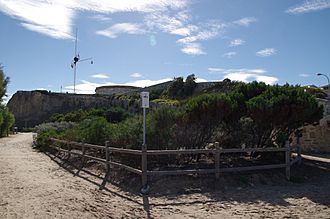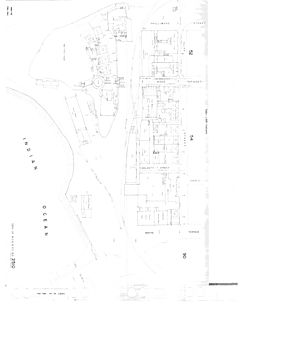Arthur Head facts for kids
Quick facts for kids Arthur Head |
|
|---|---|

Arthur Head Reserve from near the Old Kerosene Store on Bathers Beach
|
|
| General information | |
| Type | Headland |
| Location | Fremantle, Western Australia |
| Coordinates | 32°03′25″S 115°44′29″E / 32.056847°S 115.741461°E |
| Official name | Round House and Arthur Head Reserve |
| Type | State Registered Place |
| Designated | 19 November 1993 |
| Reference no. | 896 |

Arthur Head is a special place in Fremantle, Western Australia. It's a former limestone headland, which is like a small cliff sticking out into the sea. It sits on the southern side of the Swan River mouth. Today, it's also the entrance to Fremantle Harbour.
This area was chosen by Captain Charles Fremantle in May 1829. He picked it as the spot for his camp because it was a very important and strong location.
Contents
A Changing Landscape
Arthur Head has changed a lot since people from Europe settled there in the 1830s. Many buildings that once stood there have been taken down.
What Buildings Were Here?
An archaeologist named Michael Pearson studied the area in 1984. He found that many structures were built and later removed from Arthur Head. These included:
- The first lighthouse, built in 1851.
- A second lighthouse, built by convicts between 1876 and 1879. It was about 22 feet (6.7 meters) wide and 72 feet (22 meters) tall. It stopped being used in 1902.
- Two courthouses, one from 1834 and another from 1840.
- A police station complex from 1852.
- Homes for the lighthouse keeper and the harbourmaster.
What Can You See Today?
Even though many buildings are gone, some important ones are still standing at Arthur Head. These include:
- The Round House: This is the oldest building still standing in Western Australia!
- The pilots' cottages: These were homes for the harbour pilots.
- The Whalers Tunnel: This tunnel goes through Arthur Head. It made it easier to get to Bathers Beach, Fremantle and the Long Jetty.
Arthur Head During World War II
A big part of Arthur Head was used during World War II. A special slipway, called the Arthurs Head Slipway, was built there. This slipway was used to repair submarines during the war.
Images for kids


